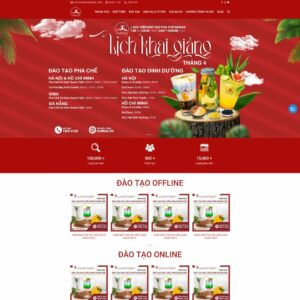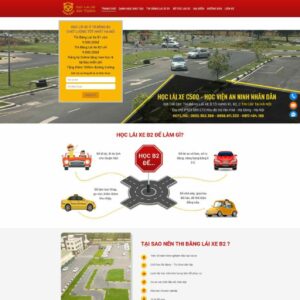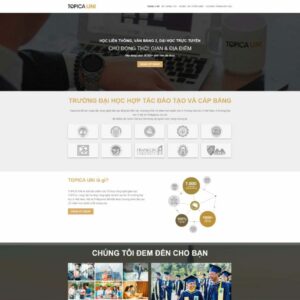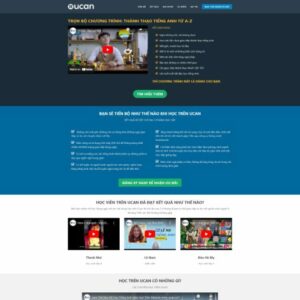
Explore the WordPress theme for bartending courses, suitable for professional training businesses and services, effectively attracting students.
WordPress theme for driving schools with categories for Services, Business, and Study Abroad, helping to build a professional and attractive website.
Discover the WordPress Course Theme 4, perfect for selling courses, designing landing pages, and effectively managing course categories.
Explore the professional WordPress theme for selling courses with categories for Courses and Landing Pages, optimized for SEO and user experience.
The WordPress theme for selling courses 7 features a beautiful design, suitable for categories like Sales and Marketing Companies, providing an optimized learning experience and an attractive interface.
The WordPress theme for tattoo training is professionally designed for spa centers, providing a relaxing experience with a modern and attractive interface.
1. Benefits of Designing a Professional Course Website
Owning a professional course website is an effective way for businesses to reach students, promote courses, and enhance their brand in the online education sector. An SEO-optimized website improves search engine rankings, attracts students, and increases course registration rates. Additionally, the website serves as a channel to provide detailed information about course content, schedules, and promotions, making it easy for students to choose the right course.
2. Essential Features of a Course Website
A course website needs to integrate all the necessary features to provide the best experience for students. The website interface should be user-friendly, easy to navigate, and optimized to meet the needs of students seeking information and registering for courses online.
2.1. User-Friendly Interface for Optimal Experience
The course website interface should be designed to be simple, modern, yet professional. Use bright, harmonious colors related to education, along with images of courses and instructors to attract students’ attention. Call-to-action (CTA) buttons like “Register Now” and “View Course Details” should be prominently placed to encourage student interaction, creating an effective online learning experience.
2.2. Detailed Course Category System
The website should have a clearly categorized course system divided into groups such as soft skills courses, professional courses, online courses, and in-person courses. Each course should have a detailed information page that includes: course introduction, teaching content, schedule, tuition fees, instructors, and promotional policies. Providing comprehensive information helps students understand the course better and make informed registration decisions.
2.3. Online Registration Feature
The online registration feature is essential for a course website. Students should be able to easily choose a course, fill in personal information, select a schedule, and choose a payment method. Integrating this feature optimizes the registration process and provides convenience for students, thereby increasing conversion rates and improving educational service quality.
3. SEO-Optimized Course Website Design Process
Designing an SEO-friendly course website is crucial for businesses to enhance their reach to students and optimize their effectiveness in the online education sector. A standard design process will create a good user experience and help the website achieve high rankings on search engines.
3.1. Conceptualizing the Interface Design
The course website interface should be designed to be modern and simple, with soft colors suitable for the education field. Use images of instructors, classrooms, and students to create a friendly and professional atmosphere. CTA buttons like “Register Now” and “Learn More” should be placed in easily visible positions to encourage student interaction. A logical layout that makes it easy to find course information will provide a better user experience.
3.2. Building Quality Content
The website content should focus on providing detailed introductions to courses, lecture content, instructor information, learning pathways, and promotional programs. Naturally incorporate related keywords like “course website design” and “online courses” into the content to optimize SEO. Sharing articles about learning knowledge and online study experiences will help attract and retain students while enhancing the company’s credibility.
3.3. On-Page SEO Optimization
Optimize SEO elements such as title tags, meta descriptions, headings, URLs, and ALT tags for images. Use internal linking between course pages and articles sharing study tips to enhance connectivity and assist students in finding information. Optimizing page load speed and user experience is also crucial for improving search engine rankings.
4. Modern Trends in Course Website Design
Current trends in course website design focus on user experience, integrating modern features, and optimizing the interface.
4.1. Modern Interface Design Focused on Content
The website interface should be designed modernly, using a logical layout to help students easily find course information. Images of instructors, students, and classrooms should be used to create a realistic, approachable feel. CTA buttons like “Register Now” and “View Course Details” should be placed prominently to encourage student action.
4.2. Integration of Online Learning Features
Integrating online learning features such as lecture videos and study materials allows students to participate directly on the website. This feature not only provides convenience for students but also helps businesses manage courses and track student progress effectively.
4.3. Mobile Optimization
The course website must be compatible with all devices such as computers, phones, and tablets, allowing students to access and register for courses anytime, anywhere. This enhances user experience and increases accessibility for students, especially those who frequently use mobile devices.
5. Choosing a Reputable Course Website Design Agency
To own a professional course website, businesses need to choose a reputable agency with experience in educational website design. This agency should provide comprehensive design, programming, and SEO optimization services to ensure the website operates effectively, attracts students, and enhances the online learning experience.
Conclusion
Designing an SEO-friendly course website is an optimal solution that helps businesses reach students, promote courses, and improve business effectiveness in the online education sector. Invest in website design today to build a professional image and achieve sustainable growth in the digital education environment.
Related Keywords:
- Course website design
- Online courses
- Professional educational website
- Online learning website design





